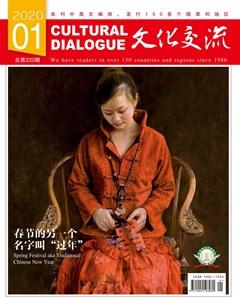寧海:正月十四鬧元宵
周衍平

浙江寧海前童古鎮(zhèn)的村民在正月初十就開始敲響鑼鼓,提醒族人元宵節(jié)將到,各家各戶要及時準(zhǔn)備。正月十一過后,大街小巷就熱鬧起來,各村的人們從四面八方匯集攏來,鑼聲鼓聲傳遍山野,活動到正月十四達(dá)到高潮。
元宵節(jié)是春節(jié)之后的第一個重要節(jié)日。正月十五鬧元宵,也是一項(xiàng)歷史悠久的傳統(tǒng)民俗文化活動。但在浙江寧海,這里的元宵節(jié)活動卻在正月十三就開始,一直延續(xù)到正月廿夜。
據(jù)明《崇禎寧海縣志》載:“元宵市廟張燈,十三日至二十日廼熄。”期間,除了傳統(tǒng)的賞燈會、猜燈謎、看大戲、舞龍舞獅外,前童行會、一市吃餾、西岙抬龍等民俗活動也是應(yīng)接不暇。
小燈人拉開元宵序幕
農(nóng)歷正月十三,當(dāng)人們還沉浸在春節(jié)的歡樂氣氛中,寧海縣長街鎮(zhèn)山頭村熱鬧的燈人會活動,卻早早地拉開了元宵節(jié)的序幕。
山頭燈人會古稱“鰲山燈會”,源出于宋代京城鬧元宵,是山頭村代代相傳的一項(xiàng)集行會與燈會為一體的民俗活動,至今已有近500年的歷史。傳說當(dāng)年有位逃難而來的馮姓官員落戶山頭,雖經(jīng)幾代繁衍,但人丁依然不興旺,于是,馮氏后人就組織了“燈人”活動,通過游燈等活動,希冀增添人丁、后代興旺。因此,“燈人”最早又叫“丁人”。
過去,山頭村燈人會在正月十三開始,持續(xù)到正月十八。正月十三那日,由百余人組成的送燈隊(duì)伍把“燈人”從村西的乾山殿送至村東的西山殿,然后連續(xù)數(shù)日在殿里唱大戲。山頭燈人會由全副鑾駕開道,接著抬出古亭、抬閣、燈人臺等。燈人臺做成宮殿樓閣模樣,上面安置著72個約10厘米高的身穿戲裝的小燈人,燈人臺下生有炭火,產(chǎn)生的熱流使上面的小燈人能夠轉(zhuǎn)動,流光溢彩,惟妙惟肖。
行會是國家級非遺項(xiàng)目
前童古鎮(zhèn)元宵行會是一項(xiàng)古老的鬧元宵民俗活動,始于明中葉,盛于明末清初,主要以鳴群鑼、抬鼓亭、舞獅子、放銃花等方式來祈愿年景豐收。2014年,前童元宵行會被列入國家級非物質(zhì)文化遺產(chǎn)名錄。
說是元宵行會,其實(shí)那里的村民在正月初十就開始鳴響群鑼,提醒族人元宵節(jié)將到,各家各戶要及時準(zhǔn)備。正月十一過后,前童的大街小巷就熱鬧起來,各村的人們從四面八方匯集攏來,鑼聲鼓聲傳遍山野,活動到正月十四達(dá)到高潮。
每年正月十四下午,所有的鼓亭和抬閣聚集一起,由大旗引路,古亭、抬閣、秋千以及游龍、舞獅隨后,一路上鑼鼓喧天、百樂交響,煞是熱鬧。行會隊(duì)伍先到塔山廟“請”出“濠公老爺”,再走街穿巷進(jìn)行巡游。這是前童人為了紀(jì)念自己的祖先童濠,俗稱“濠公老爺”。因?yàn)楣糯那巴麠l件極差,年成的豐歉,常常取決于天時。濠公一馬當(dāng)先,頃己所有,帶領(lǐng)鄉(xiāng)親歷盡艱辛,終于在白溪流中堵砩引水,灌入百渠千溝,包括古鎮(zhèn)的“八卦水系”,都源自這項(xiàng)工程。后來,前童人就以戶為單位分成若干護(hù)砩養(yǎng)渠小組,一年一輪換,直至今日。元宵紀(jì)念濠公的活動,也一直傳了下來。
長達(dá)上千米的行會隊(duì)伍浩浩蕩蕩,在游人的簇?fù)硐伦呓执铮芈范加朽l(xiāng)民在自家門前擺出紅棗、桂圓、木耳湯及各種水果點(diǎn)心,供參加行會的鄉(xiāng)親和游人免費(fèi)品嘗。隨著夜幕降臨,古鎮(zhèn)上萬燈齊亮,光影璀璨。古亭抬閣也被各色彩燈裝扮得火樹銀花,跟隨著行會隊(duì)伍游走在古鎮(zhèn)的街巷中,流光溢彩。十五日行會繼續(xù),至晚上再看點(diǎn)燈和放銃花,將“濠公”抬回廟內(nèi),整個行會才告結(jié)束。
前童古亭制作精美,造型漂亮。每個古亭各有名稱,各具內(nèi)涵,許多都是百年以上的老古董。過去,這些古亭平時都分散保管在童氏各房族,如今古鎮(zhèn)上建起了“古亭博物館”,行會結(jié)束后,這些古亭就會被送到博物館里集中展示,通過聲像還原,讓游客在平時也能領(lǐng)略前童元霄行會的盛況。
恢復(fù)失傳的花燈巡游
通常,人們都是在正月十五過元宵節(jié),而寧海人卻要在正月十四鬧元宵。舊時,寧海的元宵節(jié)除了要舞龍、舞獅和行會外,還有打車燈、劃旱船、走五獸、跳馬燈等花燈表演活動。尤其在岔路、桑洲等地,一些村子過去都有專門的花燈表演的隊(duì)伍。村民們在農(nóng)余時間扎好道具,編排好節(jié)目,每年正月初四一過,就到各村進(jìn)行巡回表演,一直持續(xù)到元宵節(jié)。正月十四那日,各村舉行行會,除了古亭抬閣、獅子龍燈外,各種花燈表演燈齊上陣,把年俗活動推向高潮。
清末民初,岔路鎮(zhèn)花堂村有專門的車燈隊(duì)和舞獅隊(duì),遠(yuǎn)近聞名。因年久失傳,車燈表演至今未能恢復(fù)。近年來,花堂村在縣非遺中心和當(dāng)?shù)卣闹С窒拢坏謴?fù)了舞獅隊(duì),還增加了舞龍、船燈、馬燈等傳統(tǒng)民俗文化表演,并整理編排了具有岔路特色的非遺曲藝節(jié)目《岔路道情》《蓮花落》等。每年的正月十四,花堂村都會進(jìn)行民俗花燈巡游活動,村民們身著彩裝,隨著聲聲鑼鼓,載歌載舞,向游人展示當(dāng)?shù)鬲?dú)特的元宵花燈文化。
正月十八才是過“大年”
大多數(shù)地方,過了元宵節(jié)便算正式過完了年,但在長街鎮(zhèn)西岙村的風(fēng)俗里,春節(jié)是“小年”,正月十八才是過“大年”的日子。這天,西岙人也迎來了一年之中最熱鬧的時刻,沿襲700多年的古老習(xí)俗“正月十八行大龍”的活動開始上演。
西岙行大龍,氣勢恢宏。當(dāng)夜幕降臨,村子里煙火斑斕,兩條由40人肩扛的巨龍?jiān)诠臉仿曋芯従彙坝巍背觯陟籼脴騾R集,形成了“雙龍飛游”的壯觀場面。這時,村民們在鞭炮聲和歡呼聲中祈福新的一年風(fēng)調(diào)雨順、安康如意。
早在南宋時期,西岙就有了十八夜抬龍的習(xí)俗,歷經(jīng)700多年,直到1929年因戰(zhàn)亂停止。為了挖掘和保護(hù)這一優(yōu)秀的民間傳統(tǒng)藝術(shù),2003年,西岙村仿制了一條頭高3.8米、身長32米的黃龍,并通過多方努力,于2004年恢復(fù)了在農(nóng)歷正月十八抬龍的習(xí)俗,中斷了近百年的“雙龍飛游”的盛景在西岙古村再現(xiàn)。2008年,西岙村又添制了一條身長39米、頭高3.5米的“青龍”。如今,西岙“正月十八夜行大龍”已被列入浙江省非物質(zhì)文化遺產(chǎn)名錄,聲名遠(yuǎn)播。
正月二十,萬人嘗餾
正月廿夜,是一市鎮(zhèn)前岙村在農(nóng)歷新年尾聲里一項(xiàng)盛大的年俗活動。全村280多戶村民每家都要點(diǎn)起灶火,擺上大鍋,制作當(dāng)?shù)氐奶厣c(diǎn)心:廿夜餾。
家家戶戶敞開大門,迎接賓朋好友和各地游客。落燈餾用番薯粉勾芡成糊加入蝦皮、蟶子、牡蠣等海鮮的成為“咸糅”,放上蘋果、菠蘿、桂圓、蜜棗、葡萄干的就成了“甜糅”。
之前,正月廿夜挨家挨戶嘗餾還只是村內(nèi)的一個傳統(tǒng)活動,村里人借機(jī)互相串門,拉拉家常,互通信息,聯(lián)絡(luò)親情。這幾年,交通方便了,遠(yuǎn)在寧波、三門、天臺等地的游客一下子多了起來。數(shù)以萬計(jì)的游客涌入小山村,一起感受這古樸、溫馨的大年氣氛。村里村外到處都是車水馬龍、人山人海,好一派熱鬧的景象。
Qiantong is a rural town in Haining, part of Ningbo in eastern Zhejiang Province. The ancient town celebrates the Spring Festival in a way and on a scale rarely seen anywhere else. After the 11 days of the first lunar month, people begin to gather in Qiantong to celebrate the Lantern Festival. If all the Spring Festival festivities before the Lantern Festival center on families, the Lantern Festival in Qiantong is a community celebration. The Lantern Festival falls on the 15th day of the lunar January across the country, but it is excitedly celebrated on the 14th day in Qiantong and many other villages in Haining. In Qiantong, the celebrations last eight days from 13th to 20th of lunar January.
On the 10th day of lunar January, residents in Qiantong hear the sound of brass gongs, announcing the advent of the Lantern Festival. Villagers around the town begin to gather gradually. On the afternoon of 14th day, a ceremony is held at a temple to have the statue of Lord Hao, demigod of the town, join a grand parade. When the statue is in the central position, the parade begins. The 1,000-meter long procession is led by people holding banners high, followed by men carrying miniature pavilions and statues and child actors in theater costumes, dragon dance and lion dance performers, musicians, and percussionists. The demigod was actually a person who initiated a water-control system in and around the town to bring flood under control and distribute water to houses and farmlands. The extensive system still exists, maintained by households in turn. The parade goes through streets and lanes. Along the lanes and streets are tables set up by all the roadside houses. On the tables are heaps of red dates, longan, cakes and sweet white fungus soup free of charge for the people taking part in the parade. The parade continues into evening when all the lanterns in the town are lit. On the 15th day, the parade resumes all the day. In the evening, all the lanterns are lit again and fireworks are set off. The parade does not finish until the statue of Lord Hao is back at the temple again.
All the miniature pavilions are antiques, more than 100 years old. In the past, these pavilions were kept separately by households of the Tong clan. Nowadays, all these pavilions are kept and maintained at a museum especially built for these pavilions. After the annual parade, these well-crafted and well decorated antiques are sent back to the museum. Tourists can visit the museum to take a look at these antiques. They can also view a short documentary to see how these miniature pavilions are carried and paraded around town during the Lantern Festival celebration.
Qiantong is not the only place where a parade is staged on the 14th day of lunar January. In some villages, the dragon dance and lion dance are individually performed. In some villages, a lantern parade is a must. In the last decades of the Qing Dynasty (1644-1911) and the early years of the Republic of China (1911-1949), Huatang, a village in Haining, had a special lion dance team and a special dance team that featured a performance called “carriage lantern”. With the assistance of the local government and the county center for intangible cultural heritage, the lion dance has been restored. The carriage lantern performance is lost forever, as no one in the village knows how to do it.
While most villages and towns in Haining celebrate the Lantern Festival on 14th day, Xiao Village celebrates the festival on 18th day of lunar January. It is the biggest day on the villages calendar. On the day, villagers parade with long dragons. The tradition has been around for more than 700 years. It started in the Southern Song Dynasty (1127-1279). It stopped in 1929 because of the war chaos. In 2003, the village made a 32-meter-long dragon with a dragon head 3.8 meters tall. The dragon is yellow. In 2004, the dragon parade resumed after a hiatus of 75 years. In 2008, the village made another huge dragon: it is a 39-meter-long with a dragon head of the same size. Nowadays, the dragon parade on the evening of 18th day of lunar January is a provincial intangible cultural heritage.
Qianao Village wraps up the Spring Festival celebration by giving a special treat to all the villagers on the evening of the 20th of lunar January. There are about 280 houses in the village. On this evening, all the houses open doors to neighbors. Neighbors go into any house they like. All houses offer a kind of a pasty delicacy made of sweet-potato powder. If it is prepared with seafood, it is salty. If it is prepared with apple, pineapple, longan, candied date, and raisin, it is sweet. Before 2008, the evening treat was just for villagers. Since 2008, it has been an attraction for tourists. Nowadays, more than ten thousand tourists flood into the village to enjoy the delicacy on the day. And it is no longer an evening event.

